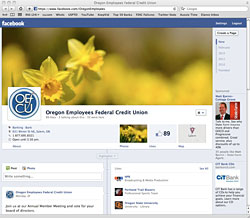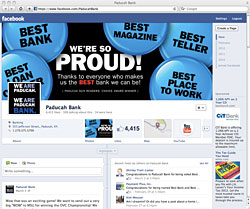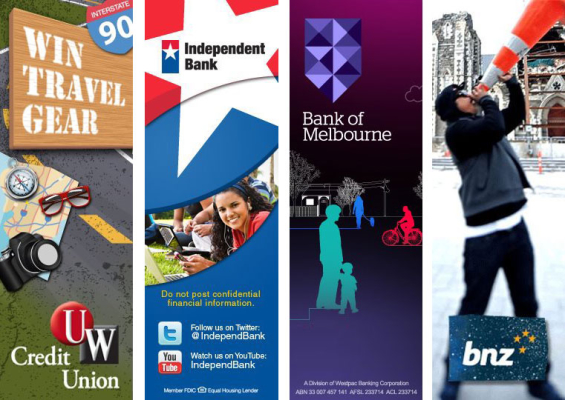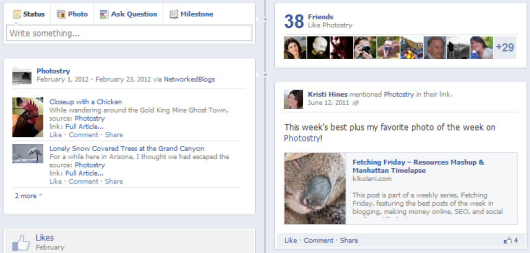Marketing on Facebook just got harder, thanks to the new Timeline layout the social media giant is forcing on company pages March 30.
At first, Facebook’s Timeline layout seems like a harmless cosmetic update. Facebook keeps forcing brand managers to tweak their pages and sure that’s annoying, but how big could the new round of Timeline changes be? However innocuous the update might seem at first, there are massive consequences.
 The rollout of Facebook’s Timeline will definitely irritate most social media admins at banks and credit unions, at least to some extent. And that’s partially what Facebook was shooting for. You see, as Facebook readies itself for the biggest IPO in a decade, they are looking at ways to curb the “free ride” many brands previously enjoyed, forcing them to instead pursue features and ads that cost money. Facebook is deliberately making it more difficult for companies to get their marketing messages in front of consumers unless they pay for it. The free lunch at the Facebook buffet is over.
The rollout of Facebook’s Timeline will definitely irritate most social media admins at banks and credit unions, at least to some extent. And that’s partially what Facebook was shooting for. You see, as Facebook readies itself for the biggest IPO in a decade, they are looking at ways to curb the “free ride” many brands previously enjoyed, forcing them to instead pursue features and ads that cost money. Facebook is deliberately making it more difficult for companies to get their marketing messages in front of consumers unless they pay for it. The free lunch at the Facebook buffet is over.
This article a summary of some of the bigger changes Timeline brings, and how they impact financial marketers.
1.) You’re Getting Throttled
Bet you thought all your Facebook fans were seeing all your updates, didn’t you? Nope. In its preparations for going public, Facebook quietly introduced a new algorithm that chokes your updates so that no more than 16% of fans see your messages. In tech terms, it’s a concept known as “throttling.”
Why would Facebook do this? Simple. Facebook wants you to pay for its Reach Generator, a new service available with premium managed accounts. Facebook says Reach Generator “makes it easy for you to regularly reach and engage 75% of your fans with meaningful content from your page.” It uses a fixed-fee price structure based on the number of fans your page has.
Bottom Line: You can reach 16% of your fans for free. Anything more that? Pay up. In other words, brands who spent tons of money buying Likes are essentially wasting 84% of their money unless they spring for Reach Generator.
This strikes many Facebook admins as grossly unfair. After all, users voluntarily opted-in to hear what companies have to say when they hit the Like button. Any user who doesn’t want to see updates from a particular brand can always hit the Unlike button, right? Why should Facebook choke, throttle, screen or otherwise filter messages users have requested? Answer: increased profits.

Why Industry Cloud for Banking?
PwC’s Industry Cloud for Banking helps deliver personalized products and services that today’s customers expect.

Fractional Marketing for Financial Brands
Services that scale with you.
2.) Cover Photo
The most visible change to under Facebook’s Timeline is the new huge visual strip at the top of company pages. This sprawling 851 x 315 pixel space is great for creating a visceral experience… provided you pick the right image. Most financial institutions will struggle finding/creating a striking Cover photo. Many will probably go with photos of their hometown, seasonal/holiday themes, or pictures of shiny, happy, smiley people (either customers or employees).
Before you run out create a giant billboard, you should know that Facebook prohibits any kind of promotional message in Cover photos. You cannot reference anything with a rate, price or other purchase information, such as “Free” or “40% off.” In fact, any call-to-action of any kind (real or implied) is expressly forbidden — e.g., “Download it at our website.” This includes inviting people to Like your page. You can’t even embed contact information, not even a web address.
Banks and credit unions with a large, vibrant library of imagery might have an easier time selecting their Cover image. But smaller financial institutions will definitely need to pay special attention to this new feature, and may need to spend some money on a high-quality stock image or custom photo. If you can’t find something you like, it’s better to go with no Cover image at all.
 Bottom Line: The visceral impact of a massive image dominating your Facebook page should not be underestimated. The image you select will play a large (if not the largest) role in people’s first impressions of your Facebook presence. Just keep it super simple, and don’t turn it into an ad.
Bottom Line: The visceral impact of a massive image dominating your Facebook page should not be underestimated. The image you select will play a large (if not the largest) role in people’s first impressions of your Facebook presence. Just keep it super simple, and don’t turn it into an ad.
Facebook says its restriction on advertising messages in Cover photos is to encourage businesses to act and interact like people. Really, Facebook’s ban is about increasing its revenue opportunities.
3.) No More Sneaky Profile Ads
The size of profile pictures has changed drastically. Facebook cut them down from 180 x 540 pixels to a measly 180 x 180. That’s the max size you can upload. The actual size of the profile picture displayed is 130 x 130 pixels — basically enough space for your logo.
Bottom Line: You’ll need to update your Facebook profile picture with something simpler and smaller immediately.
This also means you can’t “cheat” an ad out of your photo strip, as Lending Club did in the old layout.
Four examples of the old, tall profile pics financial institutions used to have. Profile images
for marketing/advertising purposes are no longer allowed in Facebook’s Timeline update.
4.) Say Goodbye to Welcome Pages
In the old Facebook system, you could build a custom landing page that all visitors to your company page would see. Many Facebook admins appreciated this feature, allowing them to explain what their page was about or presenting users with an exclusive offer. No more. Landing tabs, welcome pages… whatever you want to call them, they’re gone.
Bottom Line: Your Timeline is now your permanent Facebook landing page.
The only good news is that you can still link directly to your custom tabs and apps from sites outside of Facebook. That means you can continue linking people to “fan gate” pages from your main corporate website.
Just remember, anyone who tries to load facebook.com/yourcompany will be looking at your Timeline. If you want inbound visitors seeing one of your tabs/apps, you may need to circle back and update all your old Facebook links (at your website, email signatures, at Twitter, etc.).

How Banks Are Fortifying Their Data Against Increasing Cyber Threats
This webinar from Veeam will detail the value of working together across your organization to be better prepared in cyber defense and response readiness.
Read More about How Banks Are Fortifying Their Data Against Increasing Cyber Threats

Unlocking Digital Acquisition: A Bank’s Journey to Become Digital-First
This webinar will offer a comprehensive roadmap for digital marketing success, from building foundational capabilities and structures and forging strategic partnerships, to assembling the right team.
Read More about Unlocking Digital Acquisition: A Bank’s Journey to Become Digital-First
5.) Only 4 Tabs/Apps… Well, Actually Only 3
Applications and tabs are now displayed below the cover photo, off to the right. Only four are visible at once. The Photos tab is a permanent and cannot be removed. If you want your number of Likes displayed, that leaves you with only two spaces to play with.
The good news here is that you get to choose which two additional tabs you’d like displayed. You can even change the order of tabs to display the most relevant ones first. (Note: Photos will always be the first tab, no exceptions.)
If you have more than three or four applications, users will have to access them by clicking on the drop down arrow to the right of your tab boxes. These “hidden” applications will receive nowhere near the same amount of attention as the 2-3 featured tabs you display. So you have to be careful picking which tabs to highlight in your Facebook profile.
The images displayed for custom tabs and apps in your profile can now be customized. This allows you greater control over the visual aesthetics of your interface. To change tab preview image, click on the tab drop down, then click the edit icon in the top corner and edit settings. From there you can select a new tab image. The image should be 111 x 74 pixels exactly.
Bottom Line: You basically get 2-3 tabs and apps. Anything more than that, your users aren’t going to see, and no one will click/use them.
6.) Pinning and Starring
Admins of company Facebook pages are given two new features that can be used to draw attention to special posts. The first is “pinning.” You can pick any post and “pin” it to the top of your Timeline. The other new feature gives you the ability to highlight posts, making them double-width wherever they would normally appear in the Timeline.
You may be tempted to highlight and pin a single post. You can’t do both. It’s one or the other. You can only have one pinned message. You can, however, have multiple highlighted posts.
You may want to create visual ads for your pinned and highlighted content. You can create ads that are no larger than 404 x 404 pixels for pinned posts, and as big as 843 x 403 pixels for highlighted milestones.
Bottom Line: Pinning and highlighting is about as close as you’re going to get to unpaid advertising in Facebook’s Timeline.
7.) Direct Messages
Facebook now offers an optional feature allowing users to send direct messages to companies through their pages. This is presumably to keep Wall chatter more positive, and to quell Twitter’s dominance as the place for social media customer service.
Only users can initiate this level of interaction. You cannot send direct messages to people unless they contacted you first.
Bottom Line: For small financial institutions, this could be just one more “inbox” that must be monitored. If you don’t feel like keeping an eye on it and responding in real-time (or as close to it as possible), you might want to disable this feature. If you do turn direct messages off, just realize that anything negative anyone has to say will probably go on your public Wall.

The Power of Localized Marketing in Financial Services
Learn how to enhance your brand’s local visibility, generate more leads, and attract more customers, all while adhering to industry regulations and compliance.
Read More about The Power of Localized Marketing in Financial Services

Move the Needle from Attrition to Acquisition
Vericast’s 2024 Financial TrendWatch explores seven of today’s most critical financial services trends to provide a complete view of the current loyalty landscape.
Read More about Move the Needle from Attrition to Acquisition
8.) Penalty on 3rd Party Apps
Many social media admins — especially those at larger financial institutions — rely on third-party tools to consolidate management of their Facebook, Twitter, YouTube and LinkedIn channels. However, early reports have been circulating that posting to a Facebook page through some third party tools will result in status updates that are displayed differently than content entered directly at Facebook.com.
Compare the Facebook update Kristi Hines posted through the NetworkedBlogs app (left)
with the one she was able to compose directly in Facebook (right).
Bottom Line: If you’re using third party apps to post to Facebook, you’ll want to pay special attention to how your updates look.
9.) New Page Width
To provide additional real estate for apps, Facebook has changed (again) the maximum width from 520 to 810 pixels. This isn’t a major issue, as narrower legacy apps will float in the center of the newly widened page.
Bottom Line: Eventually, apps will either need to be extended, or even overhauled entirely.
10.) Hurry to Beat The Deadline
As this article was being written, only a handful of banks and credit unions had migrated their pages over to Timeline.
You have until March 30, 2012 to voluntarily implement the new Facebook Timeline. If you don’t make the changes yourself before then, your old Facebook page automatically be converted into the new layout, and you might not like what you see. Better to plan for it and manage it now, while there’s still some time left. Facebook had promised months ago that it would be giving company brand managers advance warning before rolling out the Timeline update. Apparently Facebook felt 30 days was ample.
Bottom Line: Get busy, and good luck!









